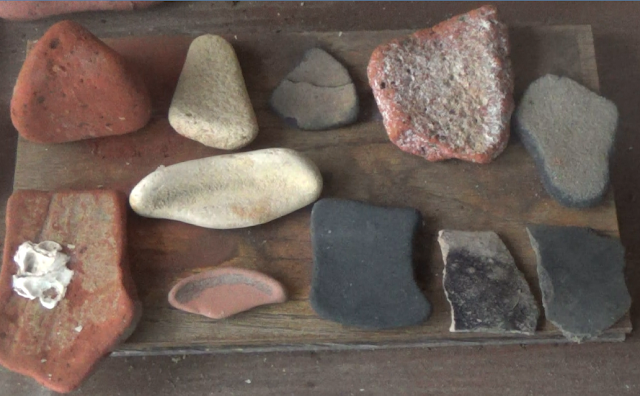Written by the TreasureGuide for the exclusive use of treasurebeachesreport.blogspot.com.
 |
| Variety of Beach Sherds. |
Glass and pottery can be one of your first hints of a land site. They can be very plentiful on the surface.
On a beach, there are times when they might be found, but most often you won't see any shards.
The picture above shows a wide variety of beach pieces.
The three big orange ones could be from olive jars or something similar.
It is easy to confuse more modern pieces with older pieces. You can learn to tell the difference though.
Modern pieces are often extruded. If you carefully inspect them, you can see how they were extruded. They look different than pieces that were wheel thrown. For one thing, they won't show the marks of the potter's hands or fingers. The surface might be more perfect, the clay more consistent and the surface more heavily glazed.
If you want to learn to tell the difference, study modern items such as drain pipes, roofing tiles, etc.
The top left piece in the picture above shows some fairly large inclusions. The other two pieces of similar color show some encrustation or other signs of sea life having been attached.
The one at bottom left corner, shows the ridges typical of wheel thrown pottery.
The two light colored pieces are actually more beige than they appear in the picture.
The lower of the two is a bottom piece and is very chalky and worn but shows only a touch of remaining glaze.
Directly below that is a small red/orange bottom piece. The glaze, which is darker, remains only in the more protected corners.
There are both Spanish and Native American pieces in that group.
The blackened beige piece second from the right side in the bottom row is incised.
 |
| Kang Hsi Porcelain |
Kang Hsi porcelain was transported on 1715 Fleet ships and has been found on Treasure Coast shipwreck beaches.
At left is a small piece of Kang Hsi porcelain. Note how white it is, how thin it is and how the blue is sinks into the top layer. That is typical.
It isn't difficult to distinguish Kang Hsi from the more common types of blue on white pottery that you will often see.
I've talked about how to identify Kang Hsi and other porcelain before.
 |
| Seal Mark Of The Kang Hsi Dynasty |
If you are lucky enough to see a marked piece, the mark shown to the left woul indicate the Kang Hsi dynasty.
---
Here is another TV show you might like - Curse of the Frozen Gold. You can also watch it online.
http://www.history.ca/curse-of-the-frozen-gold/
Thanks to Dean R. for the link.
---
Happy hunting,
TreasureGuide@comcast.net